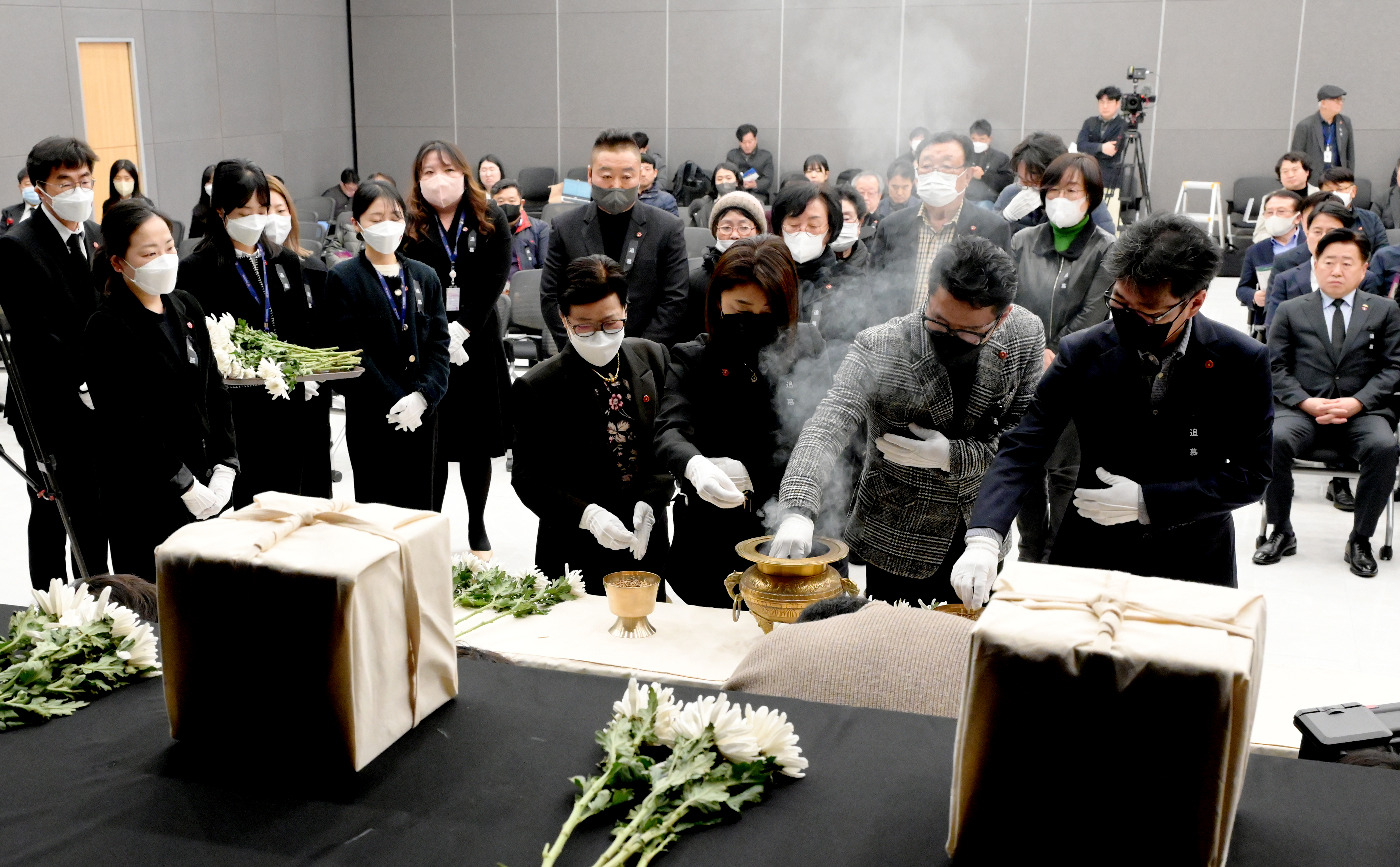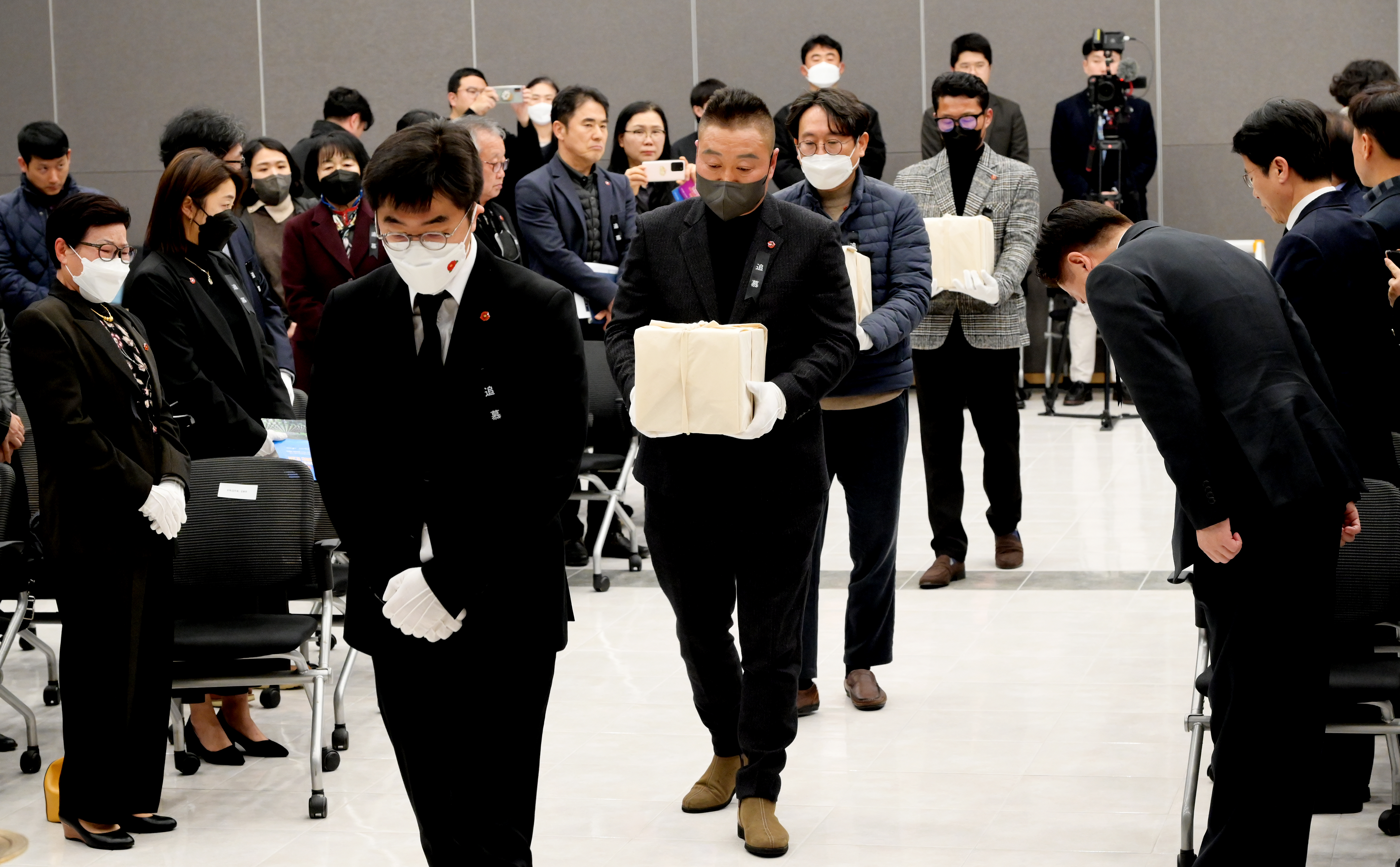Victims identified through DNA testing after 75 years
NEWS FOCUS 1
“You said you’d be back home in a week,
but it took such a long time.”
Victims identified through DNA testing after 75 years


 The Reporting Session on the Exhumed Remains Identified as Jeju 4·3 Victims was held on Feb. 28, 2023. With reverence and solemnity, those gathered in the Jeju 4·3 Peace Education Center faced the remains of Jeju 4·3 victims who returned to their families 75 years after their disappearance.
The Reporting Session on the Exhumed Remains Identified as Jeju 4·3 Victims was held on Feb. 28, 2023. With reverence and solemnity, those gathered in the Jeju 4·3 Peace Education Center faced the remains of Jeju 4·3 victims who returned to their families 75 years after their disappearance.

Families of the recently identified Jeju 4·3 victims were invited to the event that was hosted by Jeju Special Self-Governing Province and organized by the Jeju 4·3 Peace Foundation. The attendees also included Oh Young-hoon, governor of Jeju Special Self-Governing Province, Kim Kyung-hak, chairperson of the Jeju Special Self-Governing Provincial Council, Kim Chang-beom, chairperson of the Association of the Bereaved Families of Jeju 4·3 Victims, and Koh Hee-bum, president of the Jeju 4·3 Peace Foundation. Commencing the solemn ceremony, the participants were briefed on the victims’ identification results. The remains were carried into the event hall, where the victims’ families were reunited with their loved ones. The family reunion was followed by a tribute of flowers, the burning of incense, delivery of memorial remarks, enshrinement of the urns, and performance of a joint ritual.

The identified remains include Kim Chil-gyu (victim of an unlawful conviction by the court-martial, 34 years old at the time of execution), Kang Chang-geun (missing victim, 20 years old at the time of disappearance), and Kim Doo-ok (missing victim, 26 years old at the time of disappearance). Praying for the victims to find eternal rest, their bereaved families placed their names onto the urns of the remains that had finally been retrieved after being buried in the cold ground for decades. Looking at the urns, the victims’ families were unable to hold back their tears and the eyes of the audience also reddened.


Kim Jeong-soon (80), Kim Chil-gyu’s daughter, said her father had promised to be back home in a week, but it took such a long time until she got to see him again. “I am grateful that he finally returned, however long it took,” she said, expressing her gratitude to those who discovered her father.

“I never dreamed of finding my father’s remains,” said Kang Sul-saeng (77) in her first meeting with her father, Kang Chang-geun. As her father got married at 18 and went missing the following year, she never thought of the possibility of seeing her father her whole life. The elderly daughter burst into tears, saying, “Today, I finally called him ‘father’ for the first time.”
Kim Yong-heon, one of Kim Doo-ok’s nephews, recounted his memory of his father who had desperately wanted to see his missing elder brother until he passed away. “If still living, my father would be very happy today,” the victim’s nephew expressed regretfully, expecting that efforts will continue to exhume and identify remains.
Comforting the victims’ families who endured the long, mournful years, Oh Young-hoon, Kim Kyung-hak, Kim Chang-beom, and Koh Hee-bum reflected on the exhumation of remains and the DNA test results. Representatives from the public, private, and academic sectors also pledged that they would continue to discover and identify Jeju 4·3 victims’ remains.
The recently identified remains were retrieved from 2007 to 2009 where the area northeast of the Jeju International Airport runway which is oriented north to south and the northern area of the runway intersect. The victims had remained unidentified until 2022, when some of the victims’ direct and collateral family members provided their blood samples for the first time. The latest findings confirmed once again that collecting more blood samples from victims’ families increases the possibility of identifying the victims.
The technical development is also important, according to Lee Soong Deok (professor in the Department of Forensic Medicine, Seoul National University), who was in charge of genetic identification. “Above of all, however, the more families (up to third cousins) that participate in blood collection, the greater the possibility of identification,” he emphasized, asking the families of unidentified victims to show interest and take part in DNA tests.
The exhumation of Jeju 4·3 victims’ remains began in 2006, with 411 victims exhumed and 141 of them identified. Jeju Special Self-Governing Province and the Jeju 4·3 Peace Foundation will continue the exhumation and identification project this year. Authorities will expand the areas of excavation to discover those killed in regions outside Jeju before and after the Korean War, judging that many victims of unlawful convictions are buried in such massacre sites as Sannae Gollyeonggol, Daejeon, and Daegu Prison. Efforts will also continue to be made for the genetic identification of any remains exhumed from these sites, alongside the collection of more blood samples from victims’ families.
I have never thought I could find my missing father after more than 70 years have passed. My father got married at the age of 18 and went missing at the age of 19. Reportedly, he was taken to the police station and stayed there for a few days, with his whereabouts unknown afterwards. Rumor had it that he must have been sent somewhere outside Jeju Island or that he might have been killed at sea. Throughout my life, the thought kept striking me that I would never be able to see my father. Even when I saw a television advertisement for the collection of blood to identify Jeju 4·3 victims, it didn’t sound related to me so I didn’t even think that I could find my father using my blood sample. Last year, however, I decided to at least give it a try and participated in the DNA test for the first time. To my surprise, I received a phone call that they had identified some of the remains as belonging to my father. That night, I was so glad that I couldn’t sleep at all. After more than 70 years have passed, I could finally call him “father” for the first time in my life, but I was choked with tears and unable to speak.
My father, whom I missed for so many decades even in my dreams, finally returned. I don’t know how to describe this overwhelming joy, and yet the unutterable lament, over the return of my father who ended up being held dead in his daughter’s arms after seven decades. I am grateful that I could have my father’s remains enshrined in the Remains Enshrinement Hall of Jeju 4·3 Peace Park before I die. I express my sincere gratitude to everyone who has worked hard for Jeju 4·3 victims. Hopefully, more victims’ remains will be exhumed and identified soon and will comfort the pent-up sorrow of their bereaved families. Thank you. (Remarks by Kang Sul-saeng, the late Kang Chang-geun’s daughter)